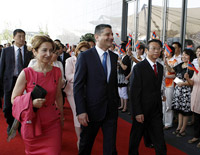We should produce products that China does not produce. This idea was said by PM Tigran Sargsyan. Certainly it is difficult to find anything that China does not produce. Accordingly, the mentioned philosophy was forgotten through the time. Till we start to think about producing something that China does not produce, the Chinese will start producing that very thing in Armenia already. Recently an Armenian-Chinese business forum was organized in Armenia in participation of 11 Chinese and 39 Armenian businessmen. The forum was organized by the Development Armenian Agency. There was a meeting in participation of the head of the Chinese delegation, president of the Huahe International company Liu Chuanyau, adviser to the trade representation in Armenia for China Guan Gang and DAA director Robert Harutyunyan. Guan Gang said that China is the second trade partner of Armenia. R. Harutyunyan said that following the expo in Shanghai in 2010 Armenian companies had started exporting to China. He says that there is a stereotype that it is very difficult to enter the Chinese market, but there are conditions that this tendency is going to grow. However, the statistics shows another picture. Even though China is the second with trade capacity after Russia, but this cannot be considered partnership and the trade is unilateral. In January-September of this year Armenia imported Chinese products worth of 331.2 million dollars, and exported to China products worth of 9,8 million dollars. The Chinese import has grown compared to the previous years, but the export to China has reduced by 59.6%. Most of the export to China was mining sector products such as copper, marble, different types of stone, etc. Armenia mainly imports from China electronic products and technical facilities. R. Harutyunyan said that he hoped the situation would change in the future and Armenia would export ready products to China. The most possible product for export to China is cognac. This is what the Chinese mostly like about Armenia. G. Gang said that the Chinese market has a great potential for selling the Armenian cognac. “Armenian cognac is famous in the whole world. Both Armenians and Chinese like strong drinks and I think that the Armenian cognac can have a great demand in the Chinese market,” he said. Gang and his colleagues had tried the Armenian cognac and they liked it much. R. Harutyunyan said that three companies – Yerevan Cognac Factory, Noy and Hayasi companies – were already exporting Armenian cognac to China. The latter says that in order to raise the capacities the parties should work on the strategy of export and import in order to have a solid representation in the Chinese market. To note, during the recent economic conference of the RPA the participants discussed the possibility of exporting cognac to China too, but according to the head of the development agency, Armenia’s potential is too small for China. Besides this issue, Chinese businessmen are also interested in investing in Armenia’s market. Gang said that a number of Chinese companies had invested in construction in Armenia and they saw a lot of opportunities for investing in Armenia in the future too. According to the official statistics, the capacity of Chinese investments in the Armenian economy in 1998-2011 amounted 1,3 billion dollars. This is impressive for the Armenian economy but the Chinese business want to go on with it. During these meetings the parties discussed the possibility of investing in other sectors such as the agriculture, mining, recoverable energy, pharmaceutics, the service and other sectors as well. The parties also agreed to work for the purpose of direct air connection between Armenia and China. The Chinese delegation said that they had been interested by Armenia’s good contacts with Iran and direct access to the CIS markets. In other words, the Chinese economy will also try to make Armenia a participant of its project to enter all markets in the world. Of course Armenia will benefit from this project if it comes true. However, besides the economic benefits these investments may contain certain risks too.
By investing in other countries China is also trying to indirectly resolve its own problems, one of which is the extra labor force. It means that in the majority of the Chinese enterprises opened abroad mostly the Chinese are employed. We have seen its precedent during the construction of the 5th block of Hrazdan’s HES, where a big number of Chinese were employed. And only the time will show how the outflow of the Chinese labor force will affect the labor market of China. At any rate, without running forward let us remember that there can’t be two good things in one place.

